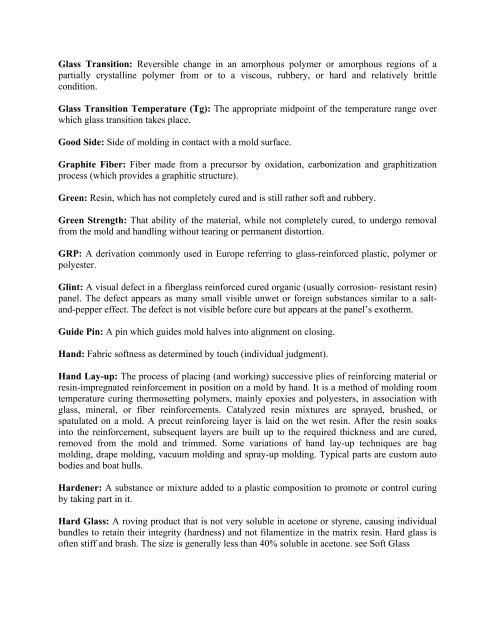Definitions /Dictionary/Glossary - nptel
Definitions /Dictionary/Glossary - nptel
Definitions /Dictionary/Glossary - nptel
You also want an ePaper? Increase the reach of your titles
YUMPU automatically turns print PDFs into web optimized ePapers that Google loves.
Glass Transition: Reversible change in an amorphous polymer or amorphous regions of a<br />
partially crystalline polymer from or to a viscous, rubbery, or hard and relatively brittle<br />
condition.<br />
Glass Transition Temperature (Tg): The appropriate midpoint of the temperature range over<br />
which glass transition takes place.<br />
Good Side: Side of molding in contact with a mold surface.<br />
Graphite Fiber: Fiber made from a precursor by oxidation, carbonization and graphitization<br />
process (which provides a graphitic structure).<br />
Green: Resin, which has not completely cured and is still rather soft and rubbery.<br />
Green Strength: That ability of the material, while not completely cured, to undergo removal<br />
from the mold and handling without tearing or permanent distortion.<br />
GRP: A derivation commonly used in Europe referring to glass-reinforced plastic, polymer or<br />
polyester.<br />
Glint: A visual defect in a fiberglass reinforced cured organic (usually corrosion- resistant resin)<br />
panel. The defect appears as many small visible unwet or foreign substances similar to a saltand-pepper<br />
effect. The defect is not visible before cure but appears at the panel’s exotherm.<br />
Guide Pin: A pin which guides mold halves into alignment on closing.<br />
Hand: Fabric softness as determined by touch (individual judgment).<br />
Hand Lay-up: The process of placing (and working) successive plies of reinforcing material or<br />
resin-impregnated reinforcement in position on a mold by hand. It is a method of molding room<br />
temperature curing thermosetting polymers, mainly epoxies and polyesters, in association with<br />
glass, mineral, or fiber reinforcements. Catalyzed resin mixtures are sprayed, brushed, or<br />
spatulated on a mold. A precut reinforcing layer is laid on the wet resin. After the resin soaks<br />
into the reinforcement, subsequent layers are built up to the required thickness and are cured,<br />
removed from the mold and trimmed. Some variations of hand lay-up techniques are bag<br />
molding, drape molding, vacuum molding and spray-up molding. Typical parts are custom auto<br />
bodies and boat hulls.<br />
Hardener: A substance or mixture added to a plastic composition to promote or control curing<br />
by taking part in it.<br />
Hard Glass: A roving product that is not very soluble in acetone or styrene, causing individual<br />
bundles to retain their integrity (hardness) and not filamentize in the matrix resin. Hard glass is<br />
often stiff and brash. The size is generally less than 40% soluble in acetone. see Soft Glass
















